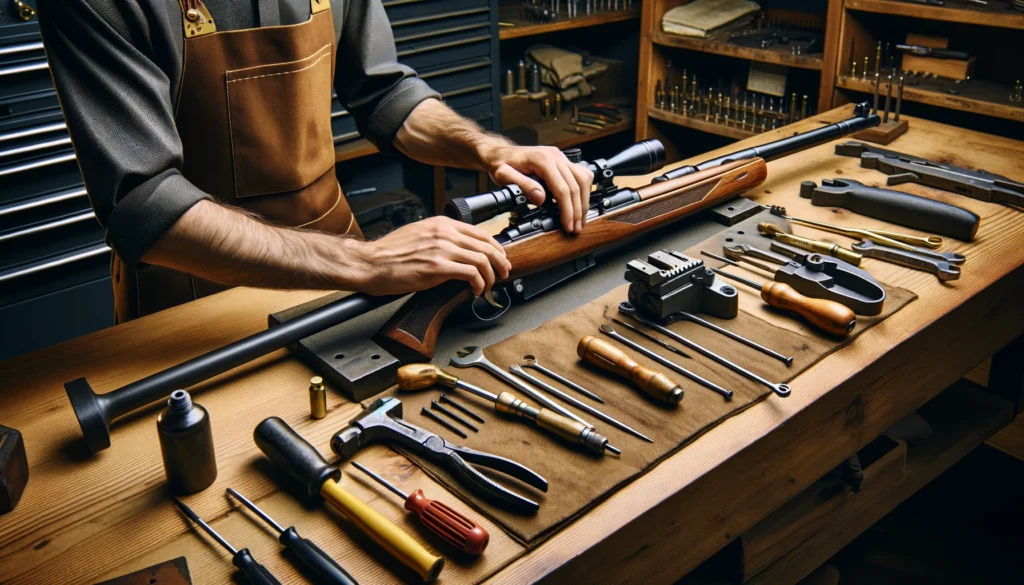Step-by-Step Guide: How to Change the Stock on a Rifle

Table of Contents
- Introduction
- 1. Safety First
- 2. Gather Necessary Tools
- 3. Removing the Old Stock
- 4. Fitting the New Stock
- 5. Final Adjustments and Checks
- 6. Maintenance and Care
- 7. Customization Options
- 8. Understanding Legal Considerations
- 9. Ergonomic Considerations
- 10. Long-Term Care and Maintenance
- Conclusion
- Frequently Asked Questions (FAQs)
- What materials are best for rifle stocks?
- How do I know if a new stock will fit my rifle?
- Can changing the stock affect the rifle’s performance?
- Can I revert to the original stock if needed?
- Are there environmental considerations with different stock materials?
- What are the typical costs involved in changing a rifle stock?
Introduction
Changing the stock on a rifle can enhance its functionality, comfort, and overall aesthetics. Whether upgrading to a stock that better fits your body or opting for a material that improves durability and performance, this guide will walk you through the steps to safely and effectively replace the stock on your rifle.
1. Safety First
1.1 Ensure the Rifle is Unloaded
- Check Chamber and Magazine: Always ensure that the rifle is completely unloaded before beginning any work. Check the chamber and magazine to confirm that no ammunition is present.
1.2 Engage Safety Mechanisms
- Safety On: If your rifle has a safety, engage it. Remove the battery or any power source if it’s a modern tactical rifle with electronic systems.
2. Gather Necessary Tools
2.1 Basic Gunsmithing Tools
- Screwdrivers and Wrenches: You’ll need various screwdrivers and possibly wrenches that fit the specific fasteners on your rifle’s stock. A gunsmithing screwdriver set is recommended to avoid damaging screws.
2.2 Workbench and Vise
- Stable Platform: Use a padded vise or gun mat on a sturdy workbench to hold your rifle securely during the stock replacement.
3. Removing the Old Stock
3.1 Access the Stock Fasteners
- Locate Screws or Bolts: Identify all screws, bolts, or other fasteners that attach the stock to the rifle’s action and barrel. These are often found on the underside of the stock.
3.2 Detach the Stock
- Careful Removal: Slowly and carefully unscrew the fasteners, keeping track of each component. Gently pull the stock away from the barrel and action. Be mindful of any cables or wiring in models with integrated systems.
4. Fitting the New Stock
4.1 Test Fit
- Dry Fit: Before attaching the new stock, align it with the rifle’s action and barrel to ensure a proper fit. Check for any areas that may need adjustment or additional padding.
4.2 Secure the New Stock
- Attach and Fasten: Once confirmed that the fit is correct, begin securing the new stock using the original or provided fasteners. Do not overtighten, as this can damage the stock or the rifle.
5. Final Adjustments and Checks
5.1 Check Alignment
- Ensure Accuracy: Make sure that the stock is aligned correctly with the barrel to ensure the accuracy of the rifle is not compromised.
5.2 Function Testing
- Operational Check: Safely perform a function test to ensure that all parts are working correctly. Check the trigger, safety, and any other mechanical parts for proper operation.
6. Maintenance and Care
6.1 Regular Inspection
- Post-Installation Checks: Regularly check the stock for any loosening of fasteners or signs of wear after your first few uses and periodically thereafter.
6.2 Cleaning
- Keep it Clean: Maintain the new stock by keeping it clean and dry. Use appropriate cleaning products that won’t damage the stock material.
7. Customization Options
7.1 Choosing Features
- Adjustable Components: Consider stocks with adjustable cheek rests, butt pads, or length of pull to enhance shooting comfort and accuracy, tailored to your specific needs.
7.2 Aesthetic Modifications
- Personalization: Stocks are available in various colors and finishes, allowing you to personalize the appearance of your rifle. Some stocks also offer the capability to attach additional accessories such as bipods, slings, and scopes.
8. Understanding Legal Considerations
8.1 Compliance with Laws
- Regulatory Awareness: Before modifying your rifle, be aware of local and federal regulations regarding firearm modifications. Certain changes can alter the classification of the weapon under the law.
8.2 Documentation and Registration
- Keeping Records: If the modification affects the registration details of the firearm, ensure you update any necessary documentation to stay compliant with firearm registration laws.
9. Ergonomic Considerations
9.1 Evaluating Ergonomics
- Comfort and Usability: When selecting a new stock, consider how the design impacts your natural shooting posture. An ergonomically designed stock can reduce fatigue and improve control during extended use.
9.2 Impact on Recoil Management
- Recoil Absorption: Different materials and designs can affect the recoil feel of the rifle. Stocks with better recoil absorption can improve shooting accuracy and comfort, especially during prolonged sessions or with higher-caliber rifles.
10. Long-Term Care and Maintenance
10.1 Routine Maintenance Schedule
- Consistent Care: Set a routine schedule to inspect, clean, and maintain not just the stock but the entire rifle to ensure optimal performance. Include checks for cracks, wear, and any loosening of fittings.
10.2 Handling and Storage
- Proper Storage: Store your rifle in a cool, dry place to prevent damage to both the stock and mechanical components. Use a gun safe or lockable cabinet that provides adequate protection from environmental elements and unauthorized access.
Conclusion
Replacing the stock on a rifle can significantly enhance your shooting experience. By following these detailed steps, you can ensure that the process is done safely and effectively, leading to better performance and comfort. Always prioritize safety and double-check your work to enjoy the benefits of your newly fitted rifle stock.
Frequently Asked Questions (FAQs)
What materials are best for rifle stocks?
- Stocks come in various materials including wood, laminates, synthetic polymers, and composites. Each has its benefits depending on your needs, such as durability, weight, and environmental resistance.
How do I know if a new stock will fit my rifle?
- Check the manufacturer’s specifications and compatibility. Many stocks are designed for specific rifle models. If unsure, consult with a professional gunsmith.
Can changing the stock affect the rifle’s performance?
- Yes, the stock can affect the rifle’s balance, weight distribution, and overall ergonomics, which can influence shooting performance and comfort. Make sure the new stock complements your shooting style and physical requirements.
Can I revert to the original stock if needed?
- Yes, as long as you retain the original stock and no permanent modifications were made to the rifle during the stock change, you can revert to the original configuration.
Are there environmental considerations with different stock materials?
- Yes, different materials react differently to environmental factors such as humidity, temperature, and exposure to elements. For instance, synthetic stocks generally offer better resistance to moisture and temperature variations compared to wood.
What are the typical costs involved in changing a rifle stock?
- Costs can vary widely based on the type of stock, material, and any additional features like adjustability or integrated components. It’s important to consider both the initial cost and any potential long-term maintenance expenses when selecting a new stock.







